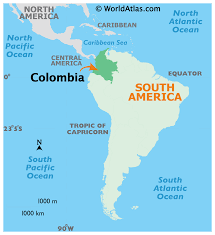
Regardless of the new president of Colombia, the country is poised for growth and expansion due to continued online commerce popularity. In the last 10 years, Colombian consumers’ tastes and preferences have changed as they seek to try new products and demand higher quality and product innovation.

The growth trajectory for Colombia is extraordinary! The ability of the country to manufacture products and ship on time to the USA makes it an ideal partner and poised to manage the labor shortages that plague the USA for the rest of the decade. To accommodate this growth, Rafael Atehortua is heading up a new division of the Manufacturing Media Consortium.
TR Cutler: What types of Colombian manufacturers are most seeking growth in the USA?
Rafael: Many Colombian jewelers, clothing designers, and fashion companies are widely known and respected. We know that when they are seen in the media, particularly the B2B media (not just end-user consumer publications), they are taken more seriously.
TR Cutler: Many of these companies are headed by Colombian businesswomen correct?
Rafael: Yes, Colombian women have taken their design acumen and combined it with brilliant business leadership. We know that tapping into the US market is the new and most logical marketing outreach for these powerful women.
TR Cutler: What are some of the biggest misconceptions that you believe Americans have about Colombia?
Rafael: First and foremost, some Americans are not yet aware how close, accessible, and progressive Colombian industry has become. Just three hours from Miami, we know that products can be made in Colombia at a much lower cost and the wages are much more affordable. There is no such thing as the great resignation in Colombia. People want to work and can actually be plant floor leaders, distribution coordinators, and accomplish production using the best practices.
TR Cutler: Beyond fashion and jewelry what other trends have you spotted among Colombian manufacturers?
Rafael: Perhaps most surprising to some American companies is the wide adoption of principled manufacturing solutions such as lean manufacturing, lean Six Sigma, Theory of Constraints, and more. Since employee engagement is reasonably easy to accomplish in Colombia, thanks to a willing workforce, focusing on best practices is the trend most obvious throughout the country.
TR Cutler: How do you think media coverage will impact the perception of Colombian manufacturing over the next decade?
Rafael: There is no doubt that myths and misconceptions must be refuted in the media. Whether social media, print media, or podcasts, we need to ensure that Colombian manufacturers, industry thought leaders, and value propositions are presented in the best possible light. This is the education component that can only happen with a spotlight and microphone on our country and industrial leadership.
Overview of Colombia
Colombia’s population was 50.3 million in 2021, up from 40.4 million in 2000. Total population will reach 53.1 million by 2030. The share of those of 0-14 years was 40.6% of the total in 1980 but had fallen to 23.2% by 2020 (still high by regional standards). The share of those over 65 years represented 8.3% of total population in 2018 and it will rise to 12.8% by 2030.
The U.S-Colombia Trade Promotion Agreement (CTPA) started a decade ago. It is a comprehensive trade agreement which eliminates tariffs and other barriers to goods and services. Although over 80% of U.S. exports of consumer and industrial products to Colombia have become duty-free, the CTPA provided a duty free tariff-rate-quota (TRQ) on certain goods that operate under a first come/first serve basis, except for rice and poultry, which are subject to auctions managed by Export Trading Companies (ETC).
Colombia is pro-actively accessing other markets and has signed Free Trade Agreements (FTAs) with various countries and trade blocs, such as Canada, the South American Common Market (MERCOSUR), the European Union, Israel, Panama, South Korea, Costa Rica and a larger trade bloc, the Pacific Alliance, which includes Mexico, Peru, and Chile.
Advantages for U.S. exporters
While there are always challenges, the advantages far outweigh the limitations. The success of American style restaurants provides an avenue for introducing U.S. recipes and food ingredients into the Colombian diet. The growing lower and middle-income population, especially youth and working women, are stimulating new consumer trends and a growth in processed foods. Market opportunities for health foods and organic products are expanding given growing obesity trends and support for healthy living campaigns. U.S. food suppliers and manufacturers have a positive reputation for food safety, availability, quality, and delivery.
Consumer-oriented products account for 23% of U.S. food and agricultural exports to Colombia. This now makes Colombia the second largest export market for consumer food products in South America, after that of Chile. Products manufactured in the U.S and sold to Colombia include processed and prepared dairy products, food preparation ingredients, fats and oils, cat and dog food, non-alcoholic beverages, chocolate, and other confectionery.
Author Profile

Thomas R. Cutler is the President and CEO of Fort Lauderdale, Florida-based TR Cutler, Inc., celebrating its 24th year. Cutler is the founder of the Manufacturing Media Consortium, including more than 9000 journalists, editors, and economists writing about trends in manufacturing, industry, material handling, and process improvement.
Cutler authors more than 1000 feature articles annually regarding the manufacturing sector. Cutler has established special divisions including Colombian manufacturing and Food & Beverage manufacturing/logistics. Cutler was recently named the Global Supply Chain journalist of the year for the second time in a row. Over 5200 industry leaders follow Cutler on Twitter daily at @ThomasRCutler. Contact Cutler at [email protected]